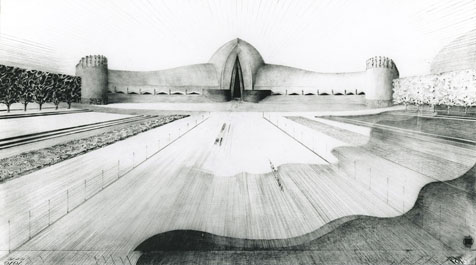This spring Sylvia Lavin gave a lecture at the Berlage Institute in Rotterdam about why she discards iconography in architecture.
She started her lecture by stating: “We do not need any more penis-buildings”. That statement was illustrated by some penis-buildings in architectural history, the penis-building in Hong Hong, the penis-buildings by Jean Nouvel, and the penis of all penisses; the Swiss Re building of Norman Foster. The feminist undertone of the argument was maybe unintentional. She did not mention the vagina-building that the Dutch architect Hendrik Wijdeveld designed in 1918 for Amsterdam.

Hong Kong Kowloon (Photographer: PFL)

Hendrik Wijdeveld - Design People’s Theatre 1918
According to Sylvia Lavin, the meaning of an iconographic building is always on a sloping plain. It rolls eventually towards a sign, she said. At first the meaning of the building might be multiple and enigmatic, but after some time the meaning narrows to a single one. And often that is a negative meaning. She illustrated that point with the Swiss Re building, which is now mostly called ‘Erotic Gherkin’, or dildo. With that argument she posits herself in this debate at the exact opposite side of Charles Jencks, who presents in his book ‘The Iconic Building’ nine possible metaphors for the Swiss Re building.
Sylvia Lavin stated that architects should focus on performance, instead of representation. As an example she put forward the design of a dildo. A representation of a dick works all right as a dildo, but a design that is based on performance such as a ‘Tarzan’ is way better. She spoke out of her own experience, she said. And even the beautifully designed ‘play wand’ dildo from Durex is better than the representation of the cock.


Dildo (Photograph: Chrisine le Duc) | Dildo (Photograph: Durex)
The lecture then dove back into the history of architecture. In the
seventies architecture came in crisis. Architecture commited ritual
suicide. Architecture was drowned (Superstudio), twisted, splitted
(Gordon Matta Clark), cutted (Peter Eisenman), hidden, burned,
etcetera. At the time a distinction was made between:
A bad object – the Duck, of Robert Venturi and Denise Scott Brown.
A good object – the Unité’s d’Habition, of Le Corbusier.
In the eighties architects started to build again. And when architects start to build, Sylvia Lavin cynically noted, all ideology is put aside. Example: Zaha Hadid theoretical projects were exchanged with banal forms as soon as she started building.
Today, we should avoid the trap of the good/bad object and instead navigate to an in-between position; the ‘good enough object’. Sylvia Lavin illustrated her theory not with a building, but with an object; the Pet Rock. In the seventies one Christmas there was a hype around this Pet Rock and it was sold by thousands. It is not more than a box, a stone, some hay, and a manual. The manual said that you should train your ‘rock’ to be a good pet. It was a joke.

Pet Rock (Photographer: UPUG)
To Sylvia Lavin the Pet Rock embodies what the ‘good enough object’ should perform like. The Pet Rock was:
- Novel. It is new.
- Quixotic. It has a fickle form; its meaning is always shifting. You
never promise too much, because you never promised anything.
- Trifling. It is completely useless, it has no purpose.
- Frivolous. It is significantly color-coded.
The Pet Rock is astonishing useless, Sylvia Lavin argued. It therefore cannot be cut, burned, etcetera, and not be sold with simple shop-talk. The Pet Rock is political, but not utopic. And it functions within capitalism, but doesn’t follow the rules of capitalism. The Pet Rock is resistant to capitalism.
That was the lecture. Should we say that the Pet Rock is a representation of your argument, Sylvia? No, she said, the Pet Rock is a diagram.
We are left with nothing but question marks. Are we as architects supposed to sell useless buildings, and promise nothing to our clients?
And sadly enough it seems as if Sylvia Lavin has absolutely no
notion of what iconography is about. The dildo’s that are designed by
‘practice’ for ‘performance’ are still iconographic, although less
literal than the dick-replica’s. The Pet Rock is also iconographic; it
refers to a rock, and it refers to a pet. And how could this
iconographic object ever be stable on the slope you describe? Because
it is useless? Even the Pet Rock has a use. As all iconography it
communicates. You can experience it, and sense it. That’s a different
kind of functionality than Le Corbusier was talking about. So what the
fuck do you mean?
from eikongraphia
'REF. > Debris' 카테고리의 다른 글
| [ MoMA ] MoMA Atlantic Pacific (0) | 2009.02.12 |
|---|---|
| Wake Up, Freak Out - then Get a Grip (0) | 2009.02.08 |
| [ Tatsuyuki Tanaka ] Fifth-Dimension Treatment (0) | 2009.02.03 |
| Dezeen podcast - Hussein Chalayan at the Design Museum (0) | 2009.01.30 |
| [ cinimodstudio ] UFO Project (for Peter Coffin) (0) | 2009.01.20 |